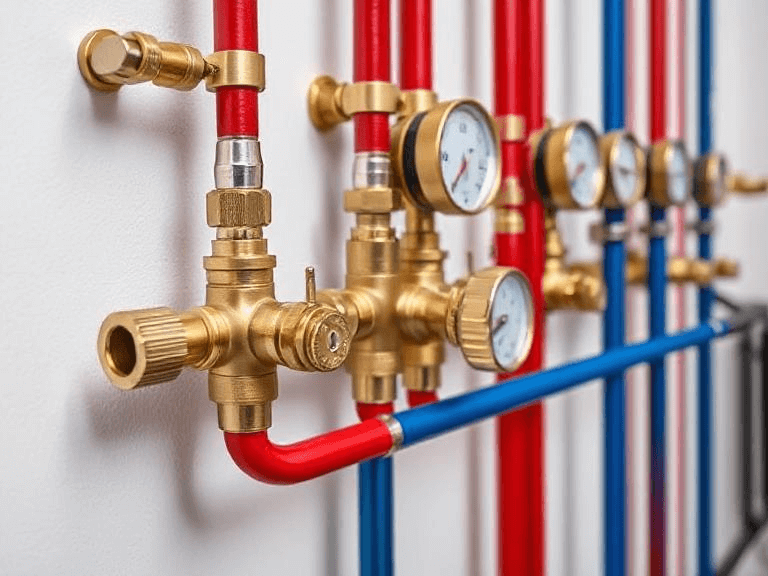How Does an Underfloor Heating Manifold Work

Imagine stepping onto a warm floor on a cold winter morning. That comforting warmth comes from an underfloor heating system, and at the heart of it is the underfloor heating manifold. If you’ve ever wondered how this crucial component works, you’re in the right place.
What is an Underfloor Heating Manifold?
Think of the underfloor heating manifold as the command center of your heating system. It’s responsible for distributing heated water evenly across different zones of your floor. Without it, your system would be inefficient, leading to cold spots or overheating in certain areas.
Most underfloor heating systems use a network of pipes beneath the floor. Hot water flows through these pipes, warming the floor above. But simply pumping hot water through without control would be ineffective. That’s where the heating manifold comes in it regulates the flow and ensures each zone gets just the right amount of heat.
Listing: Low Profile Underfloor Heating
Components of an Underfloor Heating Manifold
A typical underfloor heating manifold consists of two main sections:
- The Flow Manifold – This part sends heated water into the floor pipes.
- The Return Manifold – This collects water once it has circulated through the system and sends it back to be reheated.
Each section has multiple ports, allowing connection to different circuits. If your home has multiple rooms with underfloor heating, each room (or zone) will have its own circuit connected to the manifold system.
Listing: Underfloor Heating Pipe
How Does an Underfloor Heating Manifold Work?
1. Controlling Heat Distribution
One of the manifold’s key roles is ensuring that each zone receives heat evenly. This is done using:
- Flow Meters – These are small, clear tubes with floating indicators that show the water flow rate in each loop. They help adjust the system for even heat distribution.
- Balancing Valves – These fine-tune the flow of water to different circuits. Some areas may need more heat than others (like tiled bathrooms versus carpeted bedrooms), and these valves help manage that.
2. The Role of Actuators and Thermostats
Most modern underfloor heating systems include room thermostats. When a room needs heating, the thermostat signals an actuator on the manifold system. The actuator then opens a valve, allowing hot water to flow into that specific zone.
This setup ensures efficiency. Instead of heating the entire house at once, the system only delivers warmth where it’s needed. This means lower energy bills and more comfort.
3. Mixing Valves: Keeping Temperatures in Check
Boilers produce water at high temperatures—often too hot for underfloor heating, which typically runs at 30-50°C (86-122°F). A mixing valve attached to the manifold blends hot water from the boiler with cooler return water from the system. This keeps the temperature at an optimal level to prevent floor damage and maintain efficiency.
Read more: Wiring Underfloor Heating Yourself What You Need to Know Before You Start
Real-Life Example: How a Family Uses Underfloor Heating Manifolds
Let’s say you have a two-story home with an open living space downstairs and three bedrooms upstairs. Your underfloor heating system is divided into multiple zones:
- The living room and kitchen share one zone.
- Each bedroom has its own zone.
- The bathrooms have separate circuits since tile retains heat longer.
The heating manifold controls all these zones, adjusting the flow of hot water based on the room temperatures. When the kitchen is in use, the thermostat might call for more heat, opening the actuator and increasing flow. Meanwhile, an unused bedroom might require less heat, so the actuator stays closed.
Listing: Water Underfloor Heating
Benefits of an Underfloor Heating Manifold
Without a well-functioning underfloor heating manifold, an underfloor heating system would be inefficient and costly. A properly balanced manifold system ensures: ✔ Even heat distribution across all rooms ✔ Energy efficiency, reducing heating costs ✔ Customizable temperature control for each zone ✔ Longer lifespan for the heating system ✔ More comfortable indoor temperatures without cold spots
FAQs About Underfloor Heating Manifolds
-
Can I install an underfloor heating manifold myself?
- While technically possible, it’s best to have a professional install it to ensure proper balancing and efficiency.
-
How often should an underfloor heating manifold be serviced?
- It’s recommended to check your manifold annually to ensure proper operation and efficiency.
-
Do underfloor heating manifolds work with all flooring types?
- Yes, but different flooring materials retain heat differently. Tile and stone work best, while carpets may require higher flow rates.
Read more: How to Install an Electric Underfloor Heating Thermostat (UK Guide)
Final Thoughts
An underfloor heating manifold may not be the most talked-about part of a heating system, but it’s certainly one of the most important. It’s the key to efficient, comfortable, and cost-effective heating. Whether you’re installing a new underfloor heating system or maintaining an existing one, understanding how the manifold works can help you make better decisions for your home’s comfort and energy use.
